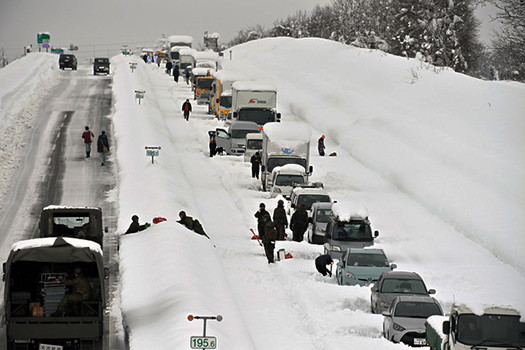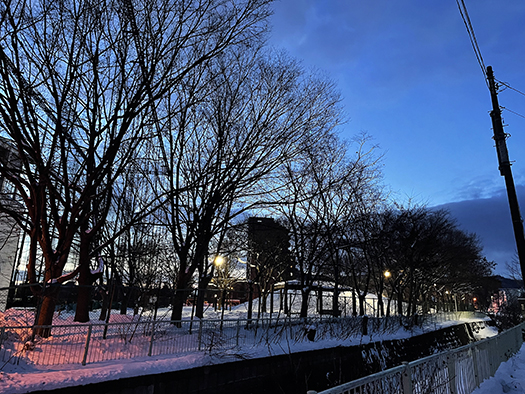


奈良の知人から先日「今朝は庭の景色が一変して雪景色」という知らせ。
文面からは奈良(橿原市)でこれだから、さぞ北海道は・・・というニュアンス。
なんですが、わたしどもの北海道は広大で一部は湿り雪での停電がありますが、
わたしの住んでいる札幌市はむしろ平年よりも高温で少雪気味。
ここ1−2日でも雨交じりで道路や敷地がグチャグチャという状況。
重い湿った、まるで北陸・新潟のような雪の状況。
この「湿雪」一番の問題点は電気の配電ネットワークへの打撃。
北海道でも一例では鉄骨配電塔が倒れて数日間、地域停電が発生したことがある。
気候としての冬の湿り雪はたぶん地球全体で見ても日本列島の特徴かも。
日本海という温暖傾向の海から発生する多量の水蒸気が
偏西風の影響を受けて日本列島の海岸に沿って降雪させる。
その時の気温状況で雪質は軽かったり重かったりする。
軽い、気温の下がった状況での降雪は比較的対応はやさしい。
ただただ寒いだけなので、住宅で言えば高断熱高気密で防衛できる。
しかし重たく湿った雪は、電気のネットワークに深甚な被害を与える。
さきの新潟の停電はまだ完全に復旧できない状況でまた降雪がきている。
先日の新潟中心の降雪・停電被害ではクルマの大渋滞にスポットが当たった。
わたしも福島県で年末、降雪の余波でクルマ大渋滞に遭遇したけれど
「関東から来るクルマがノーマルタイヤで動かなくなって大渋滞」と
東北人のみなさんは一様に口にされる。
今回の件がどうであったのかは詳細を把握していませんが、
大きな話題になっていたのは「電気自動車(EV)大丈夫か?」の点。
ガス欠が起こってもガソリンを渋滞車両に配れるけれど、
電気欠のクルマにはどうするの?という命にも関わる疑問点。
とくにEVバッテリーが低温には弱いというのはほぼ常識。
また、太陽光発電(PV)は冬場の連続する大雪時期には発電しない。
札幌の気候条件下では冬場の2−3ヶ月は発電を予期していない。
しかし考えられているのはEVとPVのワンセットの生活エネルギー対応。
当然蓄電池がそこに介在するというカタチが想定されている。
一番必要な冬場の移動手段が場合によっては「電欠」で確保できない。
どうも、この刷り込まれたライフスタイルモデルは
ヨーロッパ的な、あるいは大陸的な標準気候モデルだと思える。
そのそも、そのイギリスでは洋上風力の一本足に賭けた結果、
「思ったほど風が吹かなかった」ことで根底的な戦略見直しに迫られたし、
原発停止以降のエネルギー戦略としてロシア天然ガス一本足を選んだドイツは
ロシアの無道なウクライナ侵略を招来させてしまった。
エネルギー戦略の破綻で電力の異常高騰にヨーロッパ全域は襲われている。
ほぼ毎年のように繰り返し襲ってくるこの「湿り雪」と停電サイクルのなかで
アジア極東の変動気候に見舞われ続ける国のエネルギー戦略は
混乱する世界の「主流」追随型でいいのか、大いに疑問だと思われる。
English version⬇
Wet Snow Power Outages, Changing Climate and Humanity’s Energy Response
Renewable single energy strategy failed in Europe. It caused Russia’s spineless war. What is Nippon’s strategy under Far East Asian climate conditions? …
A friend of mine in Nara informed me the other day that the scenery in his garden had changed to snow this morning.
The text implied that since this was the case in Nara (Kashihara City, Nara Prefecture), Hokkaido must be… well…
But Hokkaido, where I live, is a vast island with power outages due to wet snow in some parts, but not in others.
However, Sapporo, where I live, is rather hotter than normal and has less snow than usual.
Even in the past day or two, the roads and grounds have been a mess due to the rain.
The snow is heavy and wet, just like in Hokuriku and Niigata.
The biggest problem with this “wet snow” is the damage to the electric power distribution network.
In one case in Hokkaido, a steel distribution tower collapsed, causing local power outages for several days.
Wet snow in winter as a climate is probably a characteristic of the Japanese archipelago as a whole.
A large amount of water vapor generated from the warm-trending Sea of Japan
The westerly winds cause snow to fall along the coasts of the Japanese archipelago.
The quality of the snow can be light or heavy depending on the temperature conditions at the time.
Snowfall under light, cooler temperature conditions is relatively easy to deal with.
Since it is just cold, it can be defended with high insulation and airtightness in terms of housing.
Heavy, wet snow, however, can cause serious damage to electrical networks.
The recent power outage in Niigata has yet to be fully restored, and another snowfall is on its way.
The recent snowfall and power outage in the center of Niigata highlighted the heavy traffic congestion of cars.
I was also in Fukushima prefecture at the end of the year when I encountered heavy car traffic jams in the aftermath of the snowfall.
I was in Fukushima prefecture at the end of the year when I encountered heavy car traffic jams in the aftermath of the snowfall.
I have also encountered heavy traffic jams in Fukushima Prefecture at the end of the year in the aftermath of the snowfall.
I don’t know the details of what happened this time.
I don’t know the details of what happened this time, but the big topic of conversation was, “Are electric vehicles (EVs) OK? point.
If you run out of gas, you can distribute gasoline to the cars in traffic, but what do you do with the cars that run out of electricity?
But what about cars that run out of electricity? This is a life-threatening question.
It is common knowledge that EV batteries are vulnerable to low temperatures.
In addition, photovoltaic (PV) power generation does not work during the continuous heavy snowfall in winter.
Under Sapporo’s climatic conditions, power generation is not expected for 2-3 months in winter.
However, what is being considered is a single set of EV and PV for daily energy needs.
Naturally, a storage battery is expected to intervene.
In some cases, the most necessary means of transportation in winter cannot be secured due to a lack of electricity.
Apparently, this imprinted lifestyle model is not
This imprinted lifestyle model seems to be a European or continental standard climate model.
And yet, in the United Kingdom, the bet on a single leg of offshore wind power has resulted in a “wind not blowing as fast as expected.
The UK was forced to fundamentally rethink its strategy after betting on a single leg of offshore wind power, which “didn’t blow as much wind as expected,” and
Germany, which chose a single leg of Russian natural gas as its energy strategy after the cessation of nuclear power plants
This led to Russia’s outrageous invasion of Ukraine.
The collapse of the energy strategy has led to an abnormal rise in the price of electricity throughout Europe.
In this “wet snow” and power outage cycle that strikes repeatedly, almost every year.
The energy strategy of a country that continues to be hit by the variable climate of the Asian Far East is
It is highly doubtful that the energy strategy of a country that continues to be hit by the variable climate of the Asian Far East can follow the “mainstream” of a world in turmoil.
Posted on 12月 25th, 2022 by 三木 奎吾
Filed under: 住宅マーケティング







コメントを投稿
「※誹謗中傷や、悪意のある書き込み、営利目的などのコメントを防ぐために、投稿された全てのコメントは一時的に保留されますのでご了承ください。」
You must be logged in to post a comment.